
Self-Guided Nature Walk Length: 2.2 km Difficulty: Easy Minimum Time: 1 hour
1. Three meters behind this marker is the trunk of a fallen ironwood tree (Dialium guianense) and on the other side of the trail are the top branches. True to its name, ironwood is a very dense, hard wood. Although it fell in 1993, this log is slow to decompose. Ironwood is used for building bridges and important posts. Pieces of this log were used as supports for the rainwater vat next to the Cockscomb Basin Wildlife Sanctuary Headquarters building. It is so hard that it is rarely used for house posts because the nails keep bending and breaking. Ironwood has small fruits that are brown when ripe. The Maya take off the skin and inside is a round seed with a spongy sour & sweet fruit. It makes a very nice sticky mixture when boiled with sugar.
Look behind marker for the leaning bush with long,
shiny, dark green leaves called "ma beiy" in Mopan
Mayan (wild ginger). On the other side of the trail
are young ma beiy plants. Wherever they go, the
Maya carry the seed of this plant. Each plant produces as many as ten bunches of small fruits,
10 - 15 in each bunch. In June and July red
immature fruits appear. By October the fruits
have begun to ripen and turn black. The fruits
are peeled to reveal the yellow fleshy part
around the seed, which is soaked until the
yellow comes off. The yellow solution is boiled
and used as a spice in soups. It is so nice,
you want more soup.
3. Just behind the marker is a natural spring bubbling out of the hillside. Because it emerges from underground, this water is cooler than the river water and continues to flow all year round. A little further downstream you will see a small
pond originating from the spring. This remains full during the dry season and provides a home to many small fish and aquatic insects. Otters (Lutra longicaudi
- local name: water dog) have been seen fishing here,
but as soon as they hear you, they make a quick and silent retreat. Look for a mud turtle (Kinosternon sp.) hunting snails or fallen fruits.
Look at the bottom of the stump for holes where jacamar (Galbula ruticauda) and blue-crowned motmot (Momotus momota) have nested. The stump is half out of the ground and half underground, so it is not completely dead. New shoots growing out of it are already small trees. The rest of the log is being returned to the soil through the decomposing action of fungi and insects. The rate of decomposition and nutrient recycling in the tropics may be up to four times faster than in temperate forests.
Notice the many epiphytes or air plants adorning the trunk of the kaway. Epiphytes are plants that grow on other plants for support or anchorage. They obtain their nutrients from rainwater that trickles down ttle branches and trunk. The epiphytes at the top with the long strap-like leaves are bromeliads and are in the same family as the pineapple. 6. This cactus-like plant with the long, spiny leaves is a bromeliad (Bromelia pinguin) that grows on the ground called "wild pineapple". The spines protect the plant from herbivores. After fruiting, the main stem dies, leaving behind small shoots that grow to mature plants. The leaves are used by the Maya to make hammocks and bags. After soaking in the stream for two days, the green part of the leaf gets soft and can be scraped away with a machete, leaving a white fiber. Strong string is made by twisting these fibers together.
To the left of the strangler tree is a stout vine with brown bark and tiny leaves. This is the very important water vine (Vitis titiifolia) - any time you are thirsty in the rainforest, you can cut this vine and drink the water. 8. The cohune palm (Orbigyna cohune) is an important component of this lowland wet forest and the largest of the Central American palms. Many different animals rest or nest among the fronds or in cavities in rotting cohune trunks. Agoutis (Dasyprocta punctata, local name: Indian rabbit) manage to chew through the tough husk of the nut to the coconut-like kernel inside. White-lipped peccaries (Tayassu pecari - local name: wari) chew the nuts and eat the inner husks. Large herds of waris pass through the forest when the cohune nuts are falling in December or January. You may notice the trampled areas where they have foraged. The Maya and others use the fronds for roof thatching and oil from the kernels in cooking and to heal dry skin and scalp. Charcoal made from the husk of these nuts was used during World War II to make filters for pilot's masks. 9. This tree is actually not a tree, but a tree fern (Alsophiia mysuroides). Like all other ferns, they are primitive plants that reproduce by spores, not seeds, and leaves are unfurled from "fiddleheads", coiled structures that emerge from the center of the plant. . Enjoy a short rest on the bench by the creek and notice how thick the forest edge vegetation is on the opposite bank as the plants compete for the sunlight in the opening. The vines streaming down the tree on your left are philodendrons (Philodendron sp), a common epiphyte in the lowland tropical forest and a common houseplant elsewhere. The long, straight trunks are used for making dugout canoes (local name: dory) because the wood is soft and easy to dig out. For the same reason, ceiba wood is not good for building. The ceiba is a sacred tree to the Maya, representing the tree of life. When a field is cut for a plantation, the ceiba trees are left. Growing in front of the ceiba tree is a custard apple (Annona reticulata). The big, round fruit of this tree are a favorite of kinkajous and people. In front of the cohune tree that is to the left of the ceiba tree is a copal tree (Protium copal). This is also a tree that is sacred to the Maya because its resin is burned as incense in religious ceremonies. Can you find two more copal trees on the other side of the trail? The large tree on the other side of the trail is a cojoton (Stemmadenia donnell-smithii). Parrots eat the fruit of this tree. 11. The fruit of this tree (Annona sp.) is another favorite of the kinkajou (Potos flavus) and of people. When green it is green and yellow when ripe. The small, heart-shaped fruit tastes like a passion fruit when the seed is sucked. 12. These two yemeri trees (Vochysia hondurensis) were killed by lightning. A tall living yemeri tree can be seen behind the shower house in the Headquarters area. The bright yellow flowers of the yemeri are seen on all the hillsides from April to June, easily visible from roads. The small seeds have wings for dispersal by the wind. 13. Here the Curassow Trail ends and our self-guided trail continues on the Rubber Tree Trail. The river in front of you is South Stann Creek, which originates in the Cockscomb Basin and flows 12 miles to the sea, crossing the Southern Highway seven miles south of Maya Center. The river supports a large fish population and other animals live in or near the river. Look for large machaca fish that feed off the bribri (Inga edulis) fruit falling from the tree that leans out over the water. Try throwing fruit into the water to see if the fish will grab it. The roots of the plants and trees along the river help to keep the hard rains from washing away the shallow tropical soil into the river. What would happen if the riverbanks were cleared? 14. Five meters to the right of this mammee apple tree (Calocarpum mammosum) was the site of the acclimation cage where Harold's troop of black howler monkeys (Alouatta pigra) was released as part of a reintroduction project in 1992. One of their favorite foods is the mammee apple, so the cage was located near this tree and the translocation dorie in May when the fruit would be ripe. That's probably why they stayed in this area. Their territory covers the Rubber Tree, Curassow and Waterfall Trails. Another troop has settled across the river. Watch for movement in the tall trees. Mammee apple trees grow to 20 meters and the wood is excellent for construction. But because people also enjoy the fruit, the tree is rarely cut down. 15. The cacao tree (Theobroma cacao) is the one with the low branches. Everywhere the Maya go they plant cacao. The fruit is green when green and yellow when ripe. Inside the seedpod contains 15 - 20 seeds covered by a white gel that is sweet. The children like to suck on the seeds. The seeds are washed and. dried in the sun so they will not spoil. Anytime the Maya want to drink cacao, they roast the seeds and remove the skin. The seeds are ground in a corn mill and a drink, either hot or cold, prepared with added black pepper, sugar and cinnamon stick. 16. Notice the well-developed buttress roots on this quamwood tree (Schizolobium parahybum). One of the most common trees of the Cockscomb Basin, the quamwood drops its small, fine leaflets during the early dry season (February to March) and produces thousands of bright yellow flowers that attract huge numbers of bee and hummingbird pollinators. The crested guan, locally called "quam", eats the flower, which accounts for the name. Each flower develops into a thin, black pod containing many seeds so that the total output of seeds is tremendous. Look for the flowers, leaves, and seedpods on the forest floor. The wood of the quamwood is too soft to be used for lumber. You are now entering a younger forest. This area was a farm that was abandoned five years earlier than the one you saw a marker #2. Thus, the forest here is in a later stage of recovery. 17. The rubber tree (Castilla elastica) was once the main source of commercial rubber, but has now been replaced by man-made synthetics. The ancient Maya used the rubber from the resin of this tree for making balls for their games. Today Mayans still use the rubber to make bags and for water-proofing garments. 18. Notice the leaning tree has scratch marks made by jaguars sharpening their claws. There are several sets of marks up the tree, each older than the one before as the tree grew. 19. In front of you is a patch of yellow heliconia plants. On the other side of the trail are two other heliconias, the false bird of paradise and rattlesnake tail. You might also see lobster claw heliconia that is completely red. There are many different species of heliconias. These plants grow along streams or river and other areas of bright sunlight. Their presence here is an indication this part of the forest has been disturbed and is in the process of regeneration. As the trees grow taller and shade increases, the heliconias will become fewer. Heliconias are pollinated by hummingbirds. Their fruits are swallowed and the seeds dispersed by many other birds. The caterpillar of the owl butterfly (Caligo memnon), one of the largest in the world, feeds on the heliconia leaves. The Maya use the leaves for covering food such as tamales. The tree with the spines on the trunk is called the "cow itch tree" for obvious reasons. About six meters ahead on the right is the tama tama tree (Inga rodrigueziana). The fruit of this tree is eaten by gibnuts and parakeets. The seedpod is yellowish when ripe and contains three to five seeds. The flesh is sucked off the seed and the seed discarded, thereby dispersing the seeds. The Rubber Tree Trail will now bring you to the River Path. Turning left, it is only 100 meters to the river, a perfect place to have lunch and enjoy a refreshing swim. A picnic table under a palapa is to the left of the trail just before you arrive at the riverside. The pond in front of the picnic table is another place you might see river otters. Walk to the far right side of the clearing by the river for an excellent view of the Outlier. Look in the tall trees across the river for howler monkeys. On the trails and around the grounds of the Headquarters, look for bare trails that have been cleared by leafcutter ants, locally called "weewee ants". They transport freshly cut leave pieces back to their underground nests, which contain up to five million workers. They use the leaves to cultivate a fungus that they eat. Their large dirt-pile nests are hard to miss, and from them radiate highways in every direction. If you look closely you will see three sizes: large soldiers, medium workers, and tiny helpers, each with their own tasks. It is a short walk up the River Path to the Cockscomb Basin Wildlife Sanctuary Headquarters. We hope you enjoyed this Self-guided Nature Walk! Click here to return to Cockscomb main page Click here for Hiking the Maya Way, by Michael Shapiro.
|

Copyright by Casado Internet Group, Belize |

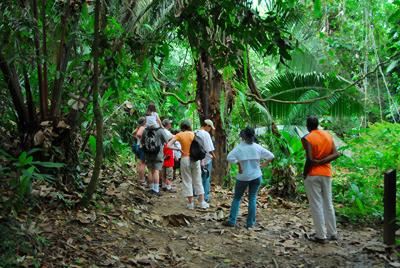
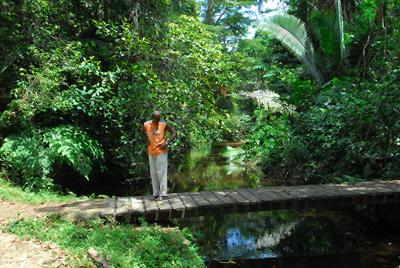
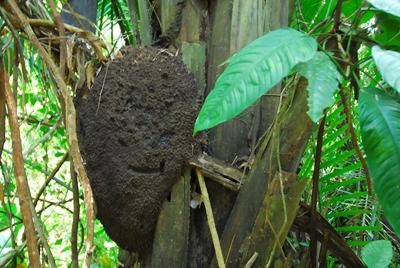
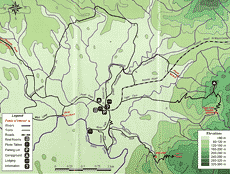
 7. Look about four meters behind this marker for the strangler fig (Ficus sp.) roots engulfing the
trunk of a kaway tree. Strangler figs begin as epiphytes, the seeds having been deposited by birds, bats or monkeys. They send down clasping roots that form a network around the host tree. This eventually strangles the host tree, leaving the strangler fig standing as an independent tree.
7. Look about four meters behind this marker for the strangler fig (Ficus sp.) roots engulfing the
trunk of a kaway tree. Strangler figs begin as epiphytes, the seeds having been deposited by birds, bats or monkeys. They send down clasping roots that form a network around the host tree. This eventually strangles the host tree, leaving the strangler fig standing as an independent tree.
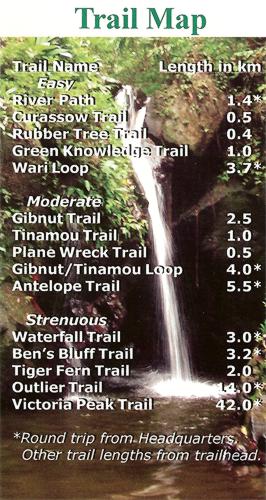 10. The ceiba tree (Ceiba pentandra) is a forest giant reaching a height of 50 meters and is found on forest margins and near rivers. Like the kaway, the trunk is supported by large buttresses. Five to ten years may pass between flowerings, but one ceiba tree can produce up to 4,000 fruits each containing 200 or more seeds. The flowers are pollinated primarily by bats, but are also visited by hummingbirds, squirrels, bees, and other insects. Kapok, the cotton-like fibers that carry the seeds away in the wind, have been used for stuffing life preservers, mattresses and cushions.
10. The ceiba tree (Ceiba pentandra) is a forest giant reaching a height of 50 meters and is found on forest margins and near rivers. Like the kaway, the trunk is supported by large buttresses. Five to ten years may pass between flowerings, but one ceiba tree can produce up to 4,000 fruits each containing 200 or more seeds. The flowers are pollinated primarily by bats, but are also visited by hummingbirds, squirrels, bees, and other insects. Kapok, the cotton-like fibers that carry the seeds away in the wind, have been used for stuffing life preservers, mattresses and cushions.